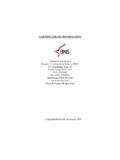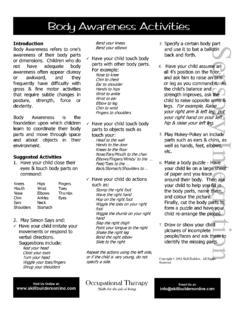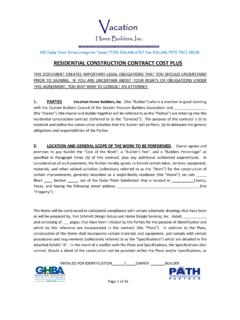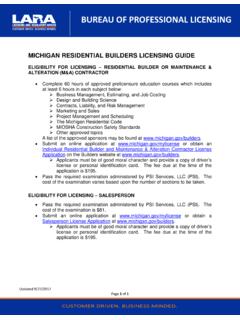Transcription of SUING BUILDERS – AFTER TRCC, RCLA
1 1 SUING BUILDERS AFTER TRCC, RCLA Mark S. McQuality SHACKELFORD, MELTON & McKINLEY, LLP 3333 Lee Parkway, 10th Floor Dallas, TX 75219 Telephone: (214) 780-1400 Facsimile: (214) 780-1401 E-Mail: CENTER FOR CONSUMER LAW UNIVERSITY OF HOUSTON LAW CENTER CONSUMER LAW BASICS KNOW THE LAW! October 23, 2009 2 MARK S. MCQUALITY SHACKELFORD, MELTON & McKINLEY, LLP 3333 Lee Parkway, 10th Floor Dallas, TX 75219 Telephone: (214) 780-1400 Facsimile: (214) 780-1401 E-Mail: SUMMARY Mark McQuality is a partner of the law firm of Shackelford, Melton & McKinley. His litigation and dispute resolution practice concentrates in the areas of residential and commercial construction and development, real estate, insurance and commercial law. Mark was actively involved in the negotiations on the amendments to the Residential Construction Liability Act starting in 1995 and subsequent amendments to that statute.
2 He is a frequent speaker for continuing education seminars and author for a variety of legal and consumer publications. LAW PRACTICE Partner with the law firm of Shackelford, Melton & McKinley, 2007-present Partner with the law firm of Bragg Chumlea McQuality, 1988-2007 Partner with the law firm of Phalen, Chumlea & McQuality, 1981-88 Associate with the law firm of Besing & Associates, 1980-81 Texas Assistant Attorney General, Consumer Protection Division, 1977-80 EDUCATION Southern Methodist University, 1977 With Honors University of Illinois, 1974 LICENSURES Texas Supreme Court, 1977 United States District Court for the Northern District of Texas, 1981 United States Court of Appeals for the Fifth Circuit, 1983 ASSOCIATIONS & MEMBERSHIPS American Bar Association, 1977-present State Bar of Texas Consumer Law Council, 1984-2003 Chairman, 1986-87, 2000-01 Advanced DTPA/Consumer/Insurance Law Course Director.
3 1994 Texas Young Lawyers Association Director, 1986-90 Outstanding Director, 1990 Dallas Bar Association, 1983-present Texas and Dallas Bar Foundations Life Fellow American Arbitration Association, Dallas Construction Advisory Council, 1997-2002 State Bar of Texas Pattern Jury Charge Committee, 1997-2000 3 TABLE OF CONTENTS I. Introduction II. Development of Residential Construction Defect Jurisprudence III. It Was Time For Change IV. What Now? V. The "Menu" of Available Economic Damages A. Section (g) B. Section (f) Comment VI. Reasonable Cost of Repairs Necessary To Cure Any Construction Defect VII. Reasonable and Necessary Cost For Replacement/Repair of Damaged Goods VIII. Reasonable and Necessary Engineering and Consulting Fees IX. Reasonable Necessary Temporary Housing Expenses X. Reduction in Market Value AFTER Repairs ("Stigma") XI. Reasonable and Necessary Attorney's Fees XII.
4 Closing Remarks 4 I. Introduction This paper is my latest of a series of seminar presentations dedicated to helping Texas homeowners and their attorneys present their residential construction defect claims and deal with the Texas Residential Construction Liability Act ("RCLA") and the Texas Residential Construction Commission Act ("TRCCA"). Included is a discussion of the 2009 sunset of the controversial Texas Residential Construction Commission ("TRCC") and an overview of proving damages in residential construction defect cases. Additionally, a brief review of the history of residential construction litigation in Texas is included to provide context. Texans, like most residents of other states, have always had a special relationship with their homes. It is their refuge. It is typically their largest consumer purchase. In the past 35+ years there has been a remarkable evolution of law impacting Texas homeowners but for homeowners it has gone from good to bad.
5 The erosion of rights for Texas homeowners for the last 18 years has been very intriguing. That trend of diminishing consumer protection started to change this year. Prior to this last legislative session, an extremely well-funded lobby for the homebuilders that contributed a substantial sum of money to key politicians had effectively worked the Texas Legislature. (Houston homebuilder and prolific political donor Bob Perry had contributed $486,000 to ten of the lawmakers on the Sunset Commission according to an article in the Houston Chronicle.) Those lobbying efforts resulted in some very favorable, "safe harbour" laws for Texas residential BUILDERS . Despite the avowed purpose of the builder lobbyists to foster "balance" in the resolution of construction disputes, builder advocates and lobbyists had, at nearly every legislate session since 1989, attempted to redesign the way residential construction defect claims are handled in Texas and further restrict homeowner rights.
6 The prolonged and most often unproductive "SIRP" process homeowners had to endure before being allowed to initiate a legal action for damages was the direct result of the TRCCA enacted in 2003. SIRPs became a successful delaying tactic for certain BUILDERS who were attempting to defeat homeowners' resolve by engaging in the war of economic and emotional attrition. Additionally, as a result of the RCLA, the types of damages available today to most consumers in these cases has been drastically reduced from what was available prior to 1993. For this reason, it is critical for attorneys representing Texas homeowners to fully understand the current residential construction laws, procedures, and how to effectively prove the damages still available to homeowners. II. Development of Residential Construction in Defect Jurisprudence Prior to 1968, construction defect claims involving Texas homeowners were typically brought under the common-law theories of breach of contract, negligence, fraud, and breach of express warranties.
7 The damages available to injured homeowners were the traditional damages available to Plaintiffs in other types of cases involving these same causes of action. 5 In 1968, the Texas Supreme Court established two independent implied warranties good workmanship and habitability that applied to homebuilders. Humbler v. Morton, 426 SW2d 554 (Tex. 1968) The new initial warranties required residential contractors in Texas to not only build homes that were suitable for habitation but also that were built to industry standards. The rationale for the creation of these two warranties was the same as other implied warranties public policy required the two warranties due to disparate bargaining positions between the parties. The Court clearly recognized the superior knowledge and power of the homebuilders in these new home transactions. The foundation of residential construction defect litigation fundamentally changed in 1973, when the Texas Legislature enacted the Texas Deceptive Trade Practices Consumer Protection Act ("DTPA"), TEX.
8 BUS. & COM. CODE et seq. This progressive legislation allowed homeowners to bring claims based not just on the traditional common-law theories, but also for alleged misrepresentations by a home builder or remodeler regarding the quality, characteristics, uses and benefits of the home or improvements, as well as for a breach of express or implied warranties. The statute specifically states common-law defenses do not apply to DTPA claims. The current version of of the DTPA still declares any waiver by a consumer of the DTPA is "contrary to public policy", "unenforceable": and "void" except in very limited circumstances. More specifically, waiver is permitted only if: (1) the waiver is in writing and is signed by the consumer; (2) the consumer is not in a significantly disparate bargaining position; and (3) the consumer is represented by legal counsel in seeking or acquiring the goods or services. The written waiver itself must also be: (1) conspicuous and in bold face type of at least 10 points in size; (2) identified by the heading "Waiver of Consumer Rights" or words of similar meaning; and (3) substantially following the words set out in the statute.
9 The evolution of the implied warranty of good workmanship continued with the Texas Supreme Court opinion in Melody Homes v. Barnes, 741 SW2d 549 (Tex. 1987). This decision expanded the implied warranty of good workmanship to remodelers of homes by applying the implied duty of good workmanship to all persons that repaired or modified goods or property. The Court also stated that public policy would prevent this implied warranty from being waived by the parties in their contract. In 1989, the manner in which residential construction defect cases were handled started to change dramatically. In that year, as part of the tort reform movement, the Texas Legislature enacted the Residential Construction Liability Act ("RCLA"), TEX. PROP. CODE et seq. The original version of the RCLA had a limited scope and focused on the builder's right to offer to "cure" any construction defect.
10 Conceptually this made sense. Homes are our largest consumer purchase. When the homes are defective, the disputes can become very emotional and expensive. Therefore, encouraging repairs rather than litigation seemed logical. However, despite all the waiver limitations and other consumer protections continued in the DTPA, the RCLA boldly declared: "To the extent of conflict between this chapter and any other law, including the Deceptive Trade Practices Consumer 6 Protection Act (Subchapter E, Chapter 17, Tex. Bus. and Com. Code) or a common-law cause of action, this chapter prevails." Tex. Prop. Code (b) The RCLA was the first statutory exemption from the DTPA. This dramatically altered the balance of power between the homeowners and homebuilders and the repercussions are still being felt by Texas consumers and families every day. The RCLA set out additional procedural requirements for consumers before they could initiate litigation for construction defects.









